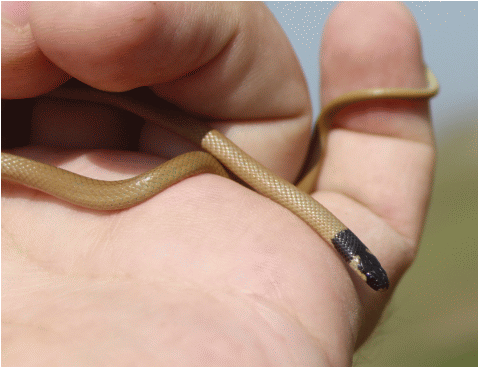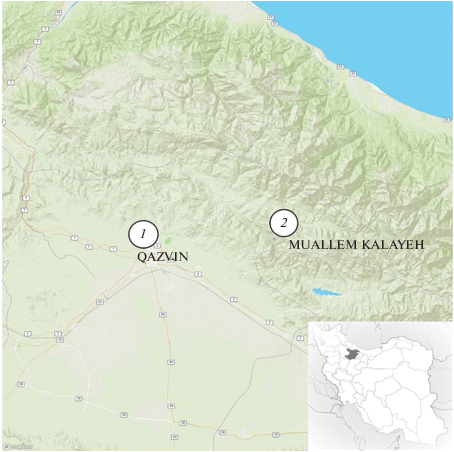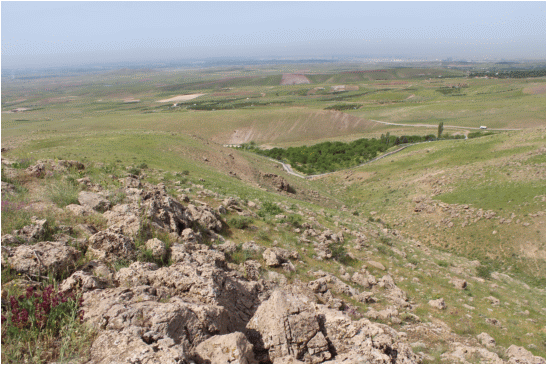Зоологический журнал, 2021, T. 100, № 6, стр. 690-692
Rediscovery of the Persian dwarf snake (Eirenis persicus, Ophidia, Colubridae) in Qazvin Province, Iran
A. A. Kidov *
Russian State Agrarian University – Moscow Timiryazev Agricultural Academy
127550 Moscow, Russia
* E-mail: kidov_a@mail.ru
Поступила в редакцию 17.05.2019
После доработки 22.09.2020
Принята к публикации 27.09.2020
For the long time the Persian dwarf snake (Eirenis persicus (Anderson 1872)) (Fig. 1), has been regarded as a widespread polymorphic species. It was believed that its range covers a vast territory from southern Armenia, south-eastern Turkey and north-eastern Iraq in the west to north-eastern Pakistan in the east (Bannikov et al., 1977; Baran, 1978; Latifi, 1991; Sindaco et al., 2000; Khan, 2002; Ananjeva et al., 2006; Tuniyev et al., 2019).
Fig. 1.
The Persian dwarf snake (Eirenis persicus). The vicinity of Moallem Kalayeh (Qazvin Province, Iran). 20 May 2019.

The main part of the range is located in Islamic Republic of Iran, where E. persicus is known from Bushehr, Fars, Hormozgan, Kerman, Khuzestan, Ilam, Kermanshah, Markazi, Tehran, Mazandaran and North Khorasan provinces (Latifi, 1991; Safaei-Mahroo et al., 2015). Later, based on the use of traditional morphometrics, ecological niche modeling, and genetic studies, it was found that E. persicus is a complex with six taxa. It is likely that each of these forms is a distinct species (Rajabizadeh et al., 2015). Moreover, in addition to the above regions, E. persicus sensu lato was found in Sistan va Baluchestan, Southern Khorasan, Golestan, Kohgiluyeh va Boyer-Ahmad, Yazd, Isfahan, Chahar Mahaal va Bakhtiari, and Lorestan provinces. E. persicus sensu stricto inhabits the territory from southern Zagros to the coast of the Persian Gulf, as well as in Fars, Isfahan, Khuzestan and Bushehr provinces (Rajabizadeh et al., 2015).
There remains uncertainty about the taxonomic status of the Persian dwarf snake from Armenia and Northern Iran (Tehran and Markazi provinces).
In the vast majority of research, there was no mention of findings of this species in Qazvin Province. However, Dotsenko (1986)11 in his PhD thesis noted a record of E. persicus for the vicinity of the city of Qazvin (Fig. 2). According to her data, a specimen of the Persian dwarf snake is stored in the Zoological Institute RAS, Saint-Petersburg.
Fig. 2.
Finds of Eirenis persicus in Qazvin Province, Iran: 1 – Qazvin town (Dotsenko, 1986), 2 – the vicinity of Moallem Kalayeh (our data).

On May 20, 2019, we discovered E. persicus on the southern macroslope of the Alborz Ridge in the vicinities of Moallem Kalayeh, Alamut-e Sharqi District, Qazvin Province (36°21′ N; 50°09′ E; 1780 m a. s. l.) (Fig. 3). The snake was found in a rocky area in mountain-xerophytic steppe. In this locality we also met other species of reptiles: Eumeces schneideri (Daudin 1802), Heremites auratus (Linnaeus 1758), Eirenis collaris (Ménétries 1832), Eirenis punctatolineatus (Boettger 1892), Telescopus fallax Fleischmann 1831, Macrovipera lebetina (Linnaeus 1758), and Xerotyphlops vermicularis (Merrem 1820). It is believed that this herpetocomplex with Mediterranean and Southwest Asiatic species (including E. persicus) is typical for the Armenian Highland and the Western part of Iranian Plateau (Tuniyev et al., 2019). Records of E. persicus also expectable in a north-western direction along southern slopes of Alborz and Talysh Ridges to the Armenian Highland. Use of MaxEnt in distribution modeling of E. persicus sensu lato that was carried by Rajabizadeh et al. (2015), also confirms this possibility. Use of MaxEnt in distribution modeling of E. persicus sensu lato that was carried by Rajabizadeh et al. (2015), also confirms this possibility.
Список литературы
Ananjeva N.B., Orlov N.L., Khalikov R.G., Darevsky I.S., Ryabov S.A., Barabanov A.V., 2006. Colored atlas of the reptiles of the North Eurasia (taxonomic diversity, distribution, conservation status). Sofia, Bulgaria: Pensoft Publishers. 245 p.
Bannikov A.G., Darevsky I.S., Ishchenko V.G., Rustamov A.K., Shcherbak N.N., 1977. The Handbook of Amphibians and Reptiles of the USSR, Moscow. 415 p. [In Russian].
Baran I., 1978. Some rare species of snakes from Turkey // Ann. Naturhist. Mus. Wien. V. 81. P. 261–265.
Khan M.S., 2002. Annotated checklist of amphibians and reptiles of Pakistan // Asiatic Herpetological Research. V. 10. P. 191–201.
Latifi M., 1991. The Snakes of Iran. Oxford: Society for the Study of Amphibians and Reptiles.159 p.
Rajabizadeh M., Nagy Z.T., Adriaens D., Avci A., Masroor R., Schmidtler J., Nazarov R.A., Esmaeili H.R., Christiaens J., 2015. Alpine-Himalayan orogeny drove correlated morphological, molecular, and ecological diversification in the Persian dwarf snake (Squamata: Serpentes: Eirenis persicus) // Zoological Journal of the Linnean Society. P. 1–36. https://doi.org/10.1111/zoj.12342
Safaei-Mahroo B., Ghaffari H., Fahimi H., Broomand S., Yazdanian M., Majd E.N., Saeed S., Yousefkhani H., Rezazadeh E., Hosseinzadeh M.S., Nasrabadi R., Rajabizadeh M., Mashayekhi M., Motesharei A., Naderi A., Kazemi S.M., 2015. The herpetofauna of Iran: checklist of taxonomy, distribution and conservation status // Asian Herpetological Research. V. 6. № 4. P. 257–290. https://doi.org/10.16373/j.cnki.ahr.140062
Sindaco R., Venchi A., Carpaneto G.M., Bologna M.A., 2000. The reptiles of Anatolia: a checklist and zoogeographical analysis // Biogeographia. V. 21. P. 441–554.
Tuniyev B.S., Orlov N.L., Ananjeva N.B., Agasian A.L., 2019. Snakes of Caucasus: Taxonomical Diversity, Distribution, Conservation. St. Petersburg–Moscow: KMK Scientific Press Ltd. 276 p.
Дополнительные материалы отсутствуют.
Инструменты
Зоологический журнал



